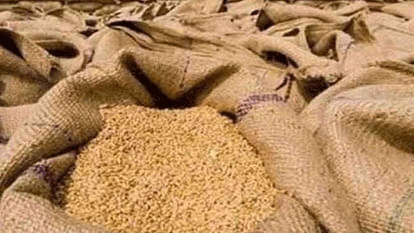Wheat prices in India have surged to record levels, sparking discussions about the possible impact on the flour industry. The rapid increase in wheat prices is primarily attributed to strong domestic demand, limited supply, and delays in the release of government-held wheat stocks. These price hikes are raising concerns about the broader economic consequences, particularly in the retail sector, where inflation has already reached a 14-month high.
Strong Demand Meets Limited Supply
The current wheat market in India is facing a stark imbalance, with demand far outpacing the available supply. Retail inflation, especially in staple foods like wheat and flour, has been escalating. Wheat prices have reached alarming levels, with the cost per metric ton in Indore, Madhya Pradesh, climbing to ₹30,000, up from ₹24,500 in April and significantly higher than the government’s Minimum Support Price (MSP) of ₹22,750 for last season’s crop.
Prominent flour mill owner Pramod Kumar shared his concerns about the supply chain, noting, “The market is facing limited wheat availability, and stockists are unwilling to release wheat at lower prices. If the government begins releasing wheat from its reserves, the supply situation will improve, and prices will likely stabilize, as we saw last year.”
Government Stock Delays
India’s government holds a substantial amount of wheat in its public reserves, but its delayed release is contributing to the price hike. In September, the government attempted to alleviate this pressure by lowering the stock limits that traders and mill owners were required to hold. However, these measures have not been effective in bringing down prices. As of early November, government wheat stocks stood at 22.3 million tons, a modest increase from the previous year but still well below the five-year average of 32.5 million tons.
Trade experts predict that prices could rise further as the new wheat season’s crop is not expected to enter the market until March 2024. A Mumbai-based dealer highlighted, “With low stock levels and the upcoming season’s wheat not expected until March, the pressure is mounting on wholesale buyers who need to continue purchasing at high prices.”
Impact on Flour Prices
With wheat prices at record highs, flour mills are already feeling the squeeze. The increased cost of wheat is likely to translate into higher prices for flour products, which could further strain household budgets and contribute to overall inflation. The price of atta (flour) could rise significantly, affecting both consumers and businesses in the food production sector, particularly biscuit manufacturers and food processors who rely on wheat flour.
In response, flour millers and bulk buyers are hoping that the government will take swift action by releasing wheat from its stocks to prevent further price escalation. The delay in government action last year led to similar price hikes, which only stabilized after the government intervention began in June 2023.
Looking Ahead: The Need for Timely Action
Given the ongoing price increases, experts and traders alike are urging the government to expedite the release of wheat from its reserves. If the situation remains unchecked, wheat prices could rise even further, placing additional strain on the food production industry and impacting inflation. Furthermore, the agricultural industry will closely monitor the upcoming harvest, hoping for better yields and a stabilization of prices.
The government’s decision in the coming months will be critical in shaping the wheat market and ensuring a steady supply of wheat at reasonable prices. Without timely intervention, the wheat shortage could lead to higher flour prices, putting more pressure on consumers and food manufacturers alike.





